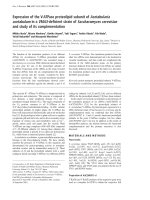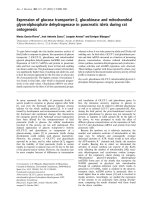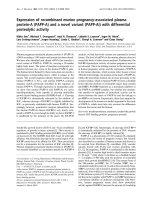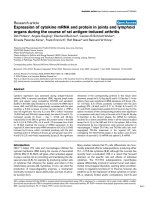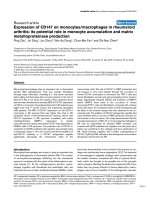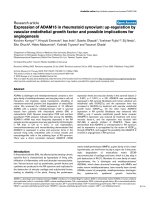Báo cáo Y học: Expression of the V-ATPase proteolipid subunit of Acetabularia acetabulum in a VMA3-deficient strain of Saccharomyces cerevisiae and study of its complementation pdf
Bạn đang xem bản rút gọn của tài liệu. Xem và tải ngay bản đầy đủ của tài liệu tại đây (922.81 KB, 8 trang )
Expression of the V-ATPase proteolipid subunit of
Acetabularia
acetabulum
in a
VMA3
-deficient strain of
Saccharomyces cerevisiae
and study of its complementation
Mikiko Ikeda
1
, Misato Hinohara
1
, Kimiko Umami
1
, Yuki Taguro
1
, Yoshio Okada
1
,YohWada
2
,
Yoichi Nakanishi
3
and Masayoshi Maeshima
3
1
Department of Nutritional Science, Faculty of Health and Welfare Science, Okayama Prefectural University, Soja, Japan;
2
Division of
Biological Science, Institute of Scientific and Industrial Research, Osaka University, Japan;
3
Laboratory of Cell Dynamics, Graduate
School of Bioagricultural Sciences, Nagoya University, Japan
The function of the translation products of six different
cDNAs for Acetabularia V-ATPase proteolipid subunit
(AACEVAPD1 to AACEVAPD6 ) was examined using a
Saccharomyces cerevisiae VMA3-deficient strain that lacked
its own gene for one of the proteolipid subunits of
V-ATPase. Expression of the cDNAs in the strain revealed
that four cDNAs from the six complemented the proton
transport activity into the vacuole, visualized by fluor-
escence microscopy. The vacuolar-membrane-enriched
fractions from the four transformants showed cross-
reactivity with antibodies against the subunits a and A of
S. cerevisiae V-ATPase. Two translation products from the
other two cDNAs were demonstrated not to be localized in
vacuolar membranes, and thus could not complement the
function of the VMA3-deficient strain. As the primary
structures deduced from the former four cDNAs are similar
but clearly different from those of the latter two, the latter
two translation products may not be able to substitute for
theVMA3 gene product.
Keywords: proton transport; proteolipid subunit; V-ATPase;
Acetabularia acetabulum; heterologous expression.
The vacuolar H
1
-ATPase (V-ATPase) is ubiquitous both in
prokaryotes and eukaryotes. This enzyme is composed of
two domains, a large peripheral domain (V
1
) and a
membrane integral domain (V
O
). The major component of
the V
O
portioncommontoallV-ATPasesisthe
N,N
0
-dicyclohexylcarbodiimide-binding 16-kDa subunit
(proteolipid subunit). In higher plants, the V-ATPase has
been well characterized biochemically and at the molecular
level [1]. Its physiological roles in plant cells are to regulate
cytoplasmic pH and ion levels, and to drive secondary active
transport of various ions and metabolites such as Ca
21
,
anions, amino acids and sugars into the vacuole. Plant
V-ATPases are large complexes (400–650 kDa) composed
of 7–10 different subunits [1]. Among these subunits, the
proteolipid subunit is present in six copies per holoenzyme
[1], which forms a functional proton channel [2].
Acetabularia acetabulum, a giant unicellular marine alga,
belongs to the Dasycladaceae family. We have already
reported the presence of V-ATPase in this organism and
demonstrated the proton-pumping activity in tonoplast-
enriched vesicles and by immunoblot analysis [3]. Three
subunits (A, B and the proteolipid subunit) form a small
multigene family encoding V-ATPase; two different cDNAs
coding the subunits A [4,5] and B [5,6], and six different
cDNAs for the proteolipid subunit [7,8] have been isolated.
In this study we focussed our attention on the function of
the translation products of six cDNAs (AACEVAPD1 to
AACEVAPD6 ) [7,8] for the proteolipid subunit of
A. acetabulum V-ATPase. By heterologous expression in a
VMA3-deficient strain of Saccharomyces cerevisiae and its
complementation study, we confirmed that four cDNAs
(AACEVAPD2, 4, 5 and 6 ) encode functional proteolipid
subunits in the yeast V-ATPase complex, but two others
(AACEVAPD1 and 3 ) do not. In addition to the results of
immunoblot analyses, the relation between the functional
complementation and the primary structures is also
discussed.
MATERIALS AND METHODS
Yeast strains
S. cerevisiae strains YN45 [MATa, ade2 –101, his3-
D
200,
leu2
D
1, lys2-801, trp1, ura3-52,
D
cup5(vma3)::LEU2,
pep4::HIS3], YN11 [MATa, ade2-101, his3-
D
200, leu2
D
1,
lys2-801, trp1-
D
63, ura3-52,
D
cup5 (vma3)::LEU2],
YPH499 [MATa, ade2-101, his3-
D
200, leu2
D
1, lys2-801,
trp1-
D
63, ura3-529], BJ5458 [MATa, ura3–52] [9], trp1,
lys2–801, leu2
D
1, his3
D
200, pep4::HIS3, prb1
D
1.6R,
can1, GAL] [10]. The YN11 strain was derived from
YPH499 strain, and YN45 strain was prepared by the use of
YN11 and BJ5458 strains.
Preparation of
AACEVAPD1 –6
5
0
RACE and 3
0
RACE products of the respective gene were
used as a template for PCR to obtain the respective full
Correspondence to M. Ikeda, Department of Nutritional Science,
Faculty of Health and Welfare Science, Okayama Prefectural
University, Kuboki 111, Soja 719-1197, Japan
(Received 23 April 2001, revised 21 September 2001, accepted
26 September 2001)
Abbreviations: V-ATPase, vacuolar H
1
-ATPase; VMA3, gene coding
for the proteolipid subunit of Saccharomyces cerevisiae V-ATPase;
GraP DH, glyceraldehyde 3-phosphate dehydrogenase.
Eur. J. Biochem. 268, 6097–6104 (2001) q FEBS 2001
length recombinant. About 100 ng of templates (pVC13/
pVC25 for AACEVAPD1, pVC39C/pVC39 for AAC-
EVAPD2, pVC10/pVC10N for AACEVAPD3,pVC18/
pVC18N for AACEVAPD4, pVC51/pVC51N for AAC-
EVAPD5 and pVC74/pVC74N for AACEVAPD6 ) [7,8]
were subjected to PCR with primer sets of AP2 and adaptor
1 for AACEVAPD1, AP2 and adaptor 1 for AACEVAPD2,
AP2 both at 5
0
and 3
0
ends for AACEVAPD3– 6, respectively.
The temperature program consisted of 20 cycles of 94 8C for
1min, 608C for 2 min, and 72 8Cfor3min.For
amplification, ExTaq DNA polymerase from TaKaRa
(Kyoto, Japan) was used. The PCR products were separated
by agarose gel electrophoresis, excised and purified over a
Qiagen DNA extraction kit (Qiagen, Duesseldorf,
Germany). The purified fragments were treated with a
Klenow fragment and ligated into the Eco RV site of
pBluescript SK (1) (pBS) (Stratagene, LaJolla, CA, USA).
After transformation in Escherichia coli XL1-Blue, plasmid
DNAs were prepared and subjected to DNA sequencing.
The respective transformant without any misreading was
innoculated in 30 mL of Luria –Bertani/ampicillin medium
and the plasmid DNA was purified over a Qiagen-Tip100
column.
Conversion of TAA to CAA and preparation of
recombinants in yeast expression vector
In the case of AACEVAPD1, 3 and 6, TAA is used as an
Acetabularia-specific codon usage (translated as Gln).
Conversion of TAA to CAA was performed by PCR as
described below.
AACEVAPD1 has two TAA codons in its open reading
frame (ORF). Fragment 1 was amplified with AP2 and
VC1*Q2 (5
0
-CACGAGCTCGGGTCTCATAACACCCATT
TGAGC-3
0
), fragment 2 with VC1*Q1 (5
0
-GCTCAAATG
GGTGTTATGAGACCCGAGCTCGTG-3
0
) and VC136*Q4
(5
0
-CCCACAAAAAGCTTGGGTTGTTGAGC-3
0
)and
fragment 3 with VC136*Q3 (5
0
-GCTCAACAACCCAAG
CTTTTTGTGGG-3
0
) and AP2. The temperature program
consisted of 20 cycles of 94 8C for 1 min, 55 8C for 1 min
and 72 8C for 2 min. About 100 ng of template (AAC
EVAPD1 ) and an ExTaq DNA polymerase were used for
amplification. The amplified fragments 1, 2 and 3 were
separated by agarose gel electrophoresis, excised from the
gels and purified as described above. The purified fragments
1, 2 and 3 (<100 ng) were used as templates and subjected
to further PCR with AP2. The temperature program
consisted of 20 cycles of 94 8C for 1 min, 60 8C for
2 min, and 72 8C for 3 min. A fragment about 820 bp was
specifically amplified, and treated in the same manner as
described above. The purified fragment was subjected to
Klenow repair and ligated into the Eco RV site of pBS. After
transformation, plasmid DNAs were isolated and subjected
to DNA sequencing. A transformant without any misreading
was innoculated in 30 mL of Luria–Bertani/ampicillin
medium and the plasmid DNA was purified over a Qiagen-
Tip100 column. The purified plasmid DNA was digested
with Sma I and Eco RI, and a fragment about 780 bp was
treated in the same manner as described above. The purified
fragment was subjected to Klenow repair and ligated into
pKT10DATG [11], which was digested with Eco RI and
treated with a Klenow fragment. After transformation in
E. coli XL1-Blue, colonies were subjected to colony
Southern hybridization. The nucleotide sequences of
plasmid DNAs were confirmed by restriction mapping and
by DNA sequencing.
In the cases of AACEVAPD3 and 6, one TAA codon in
their ORFs, thus should be converted to CAA. Fragment 1
was amplified with AP2 and VC136*Q4, and fragment 2
with VC136*Q3 and AP2 for both. The PCR conditions
were the same as AACEVAPD1. Both fragments were
digested with HindIII, and ligated by the use of a T4 DNA
ligase. The ligated fragments were subjected to agarose gel
electrophoresis, excised and purified over a Qiaex resin. The
purified fragments were digested with Not I and ligated into
a NotI-digested pBS. After transformation and mini-
preparation, the transformants were subjected to DNA
sequencing. The purified plasmid DNAs without any
misreading were digested with Not I, treated with a Klenow
fragment, and ligated into pKT10DATG and then selected as
described above.
AACEVAPD2, 4 and 5 have no TAA or TAG codon as Gln
in the ORFs. AACEVAPD2 was digested with Eco RI and
Sma I (846 bp), AACEVAPD4 with Sma I (809 bp) and
AACEVAPD5 with Sma I (750 bp). They were separated by
agarose gel electrophoresis, excised and purified over a
Qiaex resin. After treatment with a Klenow fragment, they
were ligated into pKT10DATG and selected as described
above.
Sequencing
Nucleotide sequencing of double-stranded templates was
performed with a Sequi-Therm Cycle Sequencing kit
(Epicentre Tech., Chicago, IL, USA) and a Li-Cor dNA
sequencer, Model 4000 L (Li-Cor, Lincoln, NE, USA),
according to the manufacturer’s instructions.
Expression of
AACEVAPD1 –6
in yeast
The constructs prepared as described above were introduced
into S. cerevisiae YN45 strain by the LiOAc/PEG method
[12] and grown in AHCW/Glc medium (0.17% yeast
nitrogen base without amino acid, 0.5% ammonium sulfate,
1% casein hydrolysate, 0.002% adenine sulfate dihydrate,
0.002% tryptophan, 50 m
M potassium phosphate, pH 5.5,
2% glucose).
Accumulation of
ade
fluorescent dye in vacuole and
observation by fluorescent microscopy
The transformants of the S. cerevisiae YN45 strain were
grown in YPD medium (1% yeast extract, 2% polypeptone,
2% glucose) at 30 8C, overnight to the exponential growth
phase. A total of 1 mL of culture medium was transferred to
a sterile 1.5-mL microtube and centrifuged at 2400 g for
5 min. The pellet was resuspended in 1 mL of sterile
distilled water and mixed with a Vortex mixer. Cells were
collected by centrifugation as described above. The pellet
was resuspended in 1 mL of SCD medium (0.67% yeast
nitrogen base without amino acids, 0.5% casamino acid, 2%
glucose) containing a low adenine concentration (4 mg
:
L
21
)
and tryptophan (20 mg
:
L
21
). A total of 500 mL of the
suspension was added to 5 mL of the above medium in a
50-mL tube which was shaken at 150 r.p.m./30 8C over-
night. Cells were collected in a 1.5-mL microtube by
6098 M. Ikeda et al. (Eur. J. Biochem. 268) q FEBS 2001
centrifugation as described above. The pellet was resus-
pended in 1 mL of aniline blue staining solution [1% aniline
blue in NaCl/KCl/P
i
solution (0.8% NaCl, 0.02% KCl,
0.144% Na
2
HPO
4
, 0.024% KH
2
PO
4
, 2% glucose adjusted to
pH 7.4 with 1
M NaOH)] and mixed with a Vortex mixer.
After centrifugation, the supernatant was removed and the
staining procedure was repeated twice (three times in total).
After centrifugation, the pellet was resuspended in 1 mL of
NaCl/KCl/P
i
, and centrifuged. The supernatant was
removed by decantation, cells were resuspended using a
pipette and an aliquot (3– 5 mL) was transferred onto a slide
glass. After covering with a cover glass, ade fluorescence
was observed under a fluorescent microscope with blue and
green excitation, then cell walls were observed under UV
excitation. YN45 strain as a negative control and YPH499
strain as a positive control were stained in the same manner
as described above, except that 20 mg
:
L
21
uracil was added
to the above SCD medium containing adenine and
tryptophan.
Membrane preparation from yeast
To prepare crude microsomes, we harvested cells at the mid-
exponential phase in YPD medium. Cells were treated with
Zymolyase 20T (Seikagaku Kogyo Co., Tokyo, Japan) and
further processed as described previously by Ueoka-
Nakanishi et al. [13]. The crude microsomal fraction was
subsequently subjected to a stepwise sucrose gradient
centrifugation (15% and 35% sucrose) as described
previously by Nakanishi et al. [14]. The interface between
15 and 35% sucrose solutions was collected and centrifuged
at 150 000 g for 30 min. The pellet was resuspended in a
stock buffer, frozen with liquid nitrogen and then stored at
280 8C until use as a vacuolar-membrane-enriched fraction.
Protein preparation, SDS/PAGE and immunoblotting
Proteolipid subunits were purified from the spheroplast
suspensions and the membrane fractions by chloroform/
methanol extraction according to the method described
previously by Umemoto et al. [15]. In the case of
spheroplast suspension, SDS and dithiothreitol were added
at the same concentrations as for preparing SDS/PAGE
samples.
SDS/PAGE on mini-gels and subsequent immunoblotting
were carried out as described previously [16]. Binding of
antibody was detected using ECL Western blotting detection
reagents (Amersham Pharmacia Biotech). The antibody
against 70-kDa (A) subunit of S. cerevisiae V-ATPase was a
gift from R. Hirata of the Institute of Physical and Chemical
Research (Wako, Japan), and the antibody against the
100-kDa (a) subunit of S. cerevisiae V-ATPase was
purchased from Molecular Probes Inc., Eugene, OR, USA.
RESULTS
Functional expression of
AACEVAPD2
,
4
,
5
and
6
in yeast
VMA3
-deficient strain
The cDNAs for the proteolipid subunit of A. acetabulum
V-ATPase (AACEVAPD1– 6 ) encodes 164, 176, 164, 168,
Fig. 1. Primary structures of A. acetabulum
V-ATPase, proteolipid subunit isoforms. (A)
Putative amino-acid sequences derived from
AACEVAPD1 –6 were compared and divided into
two groups. Hyphens in AACEVAPD 2–6
represent identical amino-acid residues to
AACEVAPD1. Asterisks are identical amino acids
when compared to Vma3p and Vma11p, and
colons are gaps. Underlined sequences in Vma3p
and Vma11p represent hydrophobic domains, I, II,
III and IV in the descending order. (B)
phylogenetic tree of the six isoforms of A.
acetabulum, Vma3p, Vma11p and Vma16p
according to the
CLUSTALW program.
q FEBS 2001 Expression of A. acetabulum V-ATPase subunit (Eur. J. Biochem. 268) 6099
167 and 168 amino-acid proteins [7,8]. The primary
structures of the six proteins are shown in Fig. 1: they are
divided into two groups, group 1 (AACEVAPD1 and 3 ) and
group 2 (AACEVAPD2, 4, 5 and 6 ). Alignments of those
primary structures to Vma3p (VMA3 gene product) and
Vma11p (VMA11 gene product) are also depicted in Fig. 1.
As summarized in Table 1, group 1 gave similar identities to
Vma3p and Vma11p, while group 2 showed higher identity
to Vma3p than Vma11p although the difference was slight.
The respective gene was introduced into the S. cerevisiae
strain YN45 (VMA3 coding for one of the proteolipid
subunits of V-ATPase is deleted) to examine whether the
translation product can be incorporated into the functional
V-ATPase complex. S. cerevisiae strains with ade1 or ade2
mutations such as YPH499 accumulate purine intermediate
metabolites in the vacuole, which polymerize in the
compartment and form red pigments. These strains form
red colonies on an agar plate, and the pigments accumulated
in the vacuole fluoresce green under blue excitation and red
under green excitation. When a vma mutation is introduced
into those strains, no acidification of the vacuole occurs
because of the lack of assembly of the V-ATPase complex.
Therefore, vma mutants such as YN45 are not able to
accumulate purine intermediates in the vacuole, form white
colonies on an agar plate and no fluorescence in the vacuole
is observed by microscopy. In the present experiment,
AACEVAPD1 –6 were inserted between the yeast glyceral-
dehyde 3-phosphate dehydrogenase promoter and termin-
ator of a pKT10DATG yeast–E. coli shuttle vector that
contained a 2-mm ori [11] (Fig. 2) after conversion of TAA
(A. acetabulum-specific Gln codon) to CAA as described in
Materials and methods.
All the transformants were tested for accumulation of the
purine intermediate metabolites in vacuole by fluorescence
microscopy. The results are shown in Fig. 3; AACEVAPD2,
4, 5 and 6 clearly complemented the VMA3-deficient strain,
while AACEVAPD1 and 3 did not, i.e., the translated
products of the former genes were incorporated into the
yeast V-ATPase complex and functioned as the proteolipid
subunit which forms the H
1
channel forming V
O
sector.
Intracellular distribution of the translated products of
AACEVAPD1 –6
Functional expression was confirmed for AACEVAPD2, 4, 5
and 6 as described above. To examine the intracellular
distribution of the translated products of AACEVAPD1–6 in
yeast, we carried out SDS/PAGE and silver staining for the
chloroform/methanol extracts of spheroplast suspensions
and vacuolar-membrane-enriched fractions. The results
Fig. 2. Constructs for expression of AACEVAPD1–6 in yeast. The
whole reading frames of AACEVAPD1 –6 were inserted into the site
between the yeast glyceraldehyde 3-phosphate dehydrogenase
(GraP DH) promoter and terminator of a pKT10DATG yeast–E. coli
shuttle vector.
Table 1. Alignments of the A. acetabulum six proteolipid subunits and yeast three subunits (% identity).
AACEVAPD1 AACEVAPD3 AACEVAPD2 AACEVAPD5 AACEVAPD4 AACEVAPD6 Vma3p Vma11p Vma16p
AACEVAPD1 100
AACEVAPD3 97 100
AACEVAPD2 80 80 100
AACEVAPD5 80 80 94 100
AACEVAPD4 80 79 93 94 100
AACEVAPD6 80 80 93 95 94 100
Vma3p 50 49 54 54 55 54 100
Vma11p 50 50 51 52 51 52 52 100
Vma16p 32 32 28 29 30 29 30 28 100
6100 M. Ikeda et al. (Eur. J. Biochem. 268) q FEBS 2001
shown in Fig. 4 indicated that four genes were expressed in
yeast (bands shown by arrows in Fig. 4B), the respective
proteolipid subunit from AACEVAPD2, 4, 5 and 6 was
located in vacuolar membranes but the translated products
from AACEVAPD1 and 3 were not (Fig. 4A). The latter two
translated products were supposed to be expressed in yeast
(see Discussion), but may be degraded by proteases as the
proteins were not integrated into vacuolar membranes as the
yeast V-ATPase complex.
Assembly of V-ATPase complex in vacuolar-membrane-
enriched fraction of the respective transformant
Western blot analysis was carried out to examine the
assembly of V-ATPase complex in the vacuolar-membrane-
enriched fraction of the respective transformant. The
antibody against the subunit A in yeast V
1
portion and
that against the subunit a in the yeast V
O
portion were used
for this purpose (Fig. 5). Both subunits were detected in the
membrane fractions of the four transformants (AAC
EVAPD2, 4, 5 and 6 ), but were not detectable for the two
transformants (AACEVAPD1 and 3 ). Data supported the
functional assembly of the V-ATPase complex in the former,
while no assembly occurred in the latter.
DISCUSSION
Yeast V-ATPase is the best characterized member of the
V-type ATPase family. Biochemical and genetic screens
have led to the identification of 14 genes; the majority
designated VMA (for vacuolar membrane ATPase) encode
subunits of the enzyme complex. At least eight genes encode
proteins comprising the peripherally associated catalytic V
1
subcomplex, and the other six genes code for proteins
forming the H
1
-translocating membrane V
O
subcomplex
[17]. The V
1
domain is a 570-kDa peripheral complex
composed of the subunits A –H with molecular masses of
14–70 kDa, and the V
O
domain is a 260-kDa integral
complex composed of the subunits a (100 kDa), c (17 kDa),
c
0
(17 kDa), c
00
(23 kDa) and d (36 kDa) [18]. The subunits
c, c
0
and c
00
are designated the proteolipid subunit, and have
Fig. 3. Accumulation of ade fluorescent dye in vacuoles of wild-type
cells (A, strain YPH499), vma3 mutant cells (B, strain YN45) and
the respective transformant of AACEVAPD1–6 (C– H). Fluor-
escence images of cells with aniline blue are shown in the upper panels.
Fluorescence images of cells with ade dye are depicted in the lower
panels (Blue light excitation and 8 s exposure). Both images were
observed at 1000 Â magnification. Central vacuoles are also seen as a
bright area in cells by aniline blue staining.
Fig. 4. Extraction of 16-kDa proteolipid from vacuole-membrane
enriched fraction(s) (A) and spheroplast suspension (B) with organic
solvent. (A) Vacuole-enriched membrane fractions (< 30 mg) from
YPH499 (lane 1, wild-type), YN45 (lane 2:, VMA3-deficient strain) and
transformants of AACEVAPD1–6 (lane 3–8) were washed with EDTA,
extracted with chloroform/methanol solution, solubilized in SDS
sampling buffer, and subjected to SDS/PAGE (15% gel). The gel was
stained with silver. (B) An aliquot (0.5 mL) of spheroplast suspension was
extracted with chloroform/methanol in the presence of SDS and
dithiothreitol and the half was subjected to SDS/PAGE. White arrows
indicate the proteolipid subunit incorporated into vacuolar membrane.
q FEBS 2001 Expression of A. acetabulum V-ATPase subunit (Eur. J. Biochem. 268) 6101
been reported by Hirata et al. [19] to be the gene products of
VMA3, VMA11 and VMA16 named Vma3p (160 amino acid
with Glu137], Vma11p (164 amino acids with Glu145) and
Vma16p (213 amino acids with Glu108), respectively.
Umemoto et al. demonstrated that disruption of the VMA3
gene caused complete loss of the vacuolar membrane
H
1
-ATPase activity and the occurrence of vacuolar
acidification in vivo [20]. In addition, they found that the
Vma3p was indispensable for the assembly of subunits A
and B. Hirata et al. [19] investigated the functions of
Vma11p and Vma16p in the S. cerevisiae V-ATPase
complex, and reported that the two subunits c
0
and c
00
are
essential for function and assembly of the V-ATPase
complex into the vacuolar membrane. They also reported
that VMA11p and VMA16p exist at lower levels than
Vma3p in the vacuolar membranes, although the exact
molar ratio of the three proteins could not be estimated.
Forgac described in a recent minireview [21] that the V
O
domain consisted of six copies of the c/c
0
subunits and single
copies of the other subunits a, c
00
and d.
As described earlier, we have isolated six cDNAs
encoding the putative proteolipid subunits of A. acetabulum
V-ATPase [7,8]. The length of the cDNAs varies (AAC
EVAPD1, 736 bp; AACEVAPD2, 825 bp, AACEVAPD3,
1032 bp; AACEVAPD4, 752 bp; AACEVAPD5, 722 bp;
AACEVAPD6, 826 bp), and the sequences of their 5
0
and 3
0
untranslated regions are divergent. The putative gene
products are proteins of 164 amino acids with Glu142,
176 with Glu156, 164 with Glu142, 168 with Glu148, 167
with Glu147 and 168 with Glu148 for AACEVAPD1–6,
respectively. The Northern blot analysis showed a different
expression ratio, AACEVAPD4 ¼ 6 3 . 2 ¼ 5 1
in descending order (data not shown). Judging from the
primary structures in Fig. 1A, they are divided into two
groups, group 1 and group 2 as described in the Results
section. Are all the gene products in these six proteolipid-
coding genes functional and all integrated into V
O
subcomplex of the vacuolar membrane H
1
-ATPase of
A. acetabulum? In the present study, we carried out a
complementation study with the vma3 mutant for the
respective gene of A. acetabulum to answer this question.
As a result, group 2 proteins complemented the function of
the subunit c in the vma3 mutant, while group 1 protein
could not in the mutant (Fig. 3). Further biochemical
analyses also supported the finding in vivo; chloroform/
methanol extractable proteolipids (Fig. 4A) and Western
blot analysis of the vacuolar-membrane-enriched fractions
(Fig. 5). Among the transformants of the complementable
four genes, the AACEVAPD2 product appears to be present
in lower amounts in the vacuolar membrane compared to the
wild-type and transformants AACEVAPD4, 5 and 6
(compare Figs 4 and 5). It may be due to the larger
molecular size of the product, 176 amino acids with the
longest N-terminal sequence among group 2 proteins (see
Fig. 1). Functional assembly is possibly suppressed by the
configuration of the product at the N-terminal region.
Alignment data suggested that group 2 proteins are
slightly more homologous to Vma3p than the group 1
protein Vma11p (Table 1). This could give a feasible
explanation for the complementability of the group 2
proteins for the yeast vma3-mutant. A comparison of the
structures, especially in the four hydrophobic domains
(underlined sequences in Fig. 1A), showed that domains I
and III are most divergent in group 1 and 2 proteins. The
results we obtained indicate that these two domains may
play a critical role in complementability. The genes
AACEVAPD1 and 3 were constructed in another yeast
expression vector, pYES2, which were tested for accumu-
lation of ade fluorescent dye after galactose induction.
When the genes were overexpressed by induction,
accumulation of the dye in the vacuoles of both
transformants was observed, and the intensity was weaker
than that in the transformants of the other four genes
constructed in pYES2 (data not shown). We did not take into
consideration whether the A. acetabulum six proteolipid
subunits function as Vma16p in yeast V-ATPase complex, as
the primary structures deduced from the six genes have low
identity (29–30%) to Vma16p. Also, Vma16p has a larger
molecular size (213 amino acids) than any of the
A. acetabulum gene products (164 –176 amino acids).
Heterologous expression and complementation studies of
the six genes in the yeast VMA11-deficient strain could give
more information on that point, and studies by disruption of
the VMA11 gene are now in progress.
Isoforms of V-ATPase subunits have so far been reported
in higher plants as reviewed by Sze et al. [1], three isoforms
of the subunit a of mouse enzyme [22,23], four isoforms of
the proteolipid subunit in Caenorhabditis elegans [24] and
two isoforms of the subunit A in human osteoclastoma [25].
Isoforms in higher plants have been reported to be tissue-
specific [26] or stress-induced, such as salinity stress [27].
Three isoforms of the subunit a in mouse were expressed in a
tissue-specific manner [22], and the a3 isoform in mouse
osteoclast was suggested to be a component of the plasma
membrane V-ATPase, but the a1 isoform was localized in
Fig. 5. Detection of subunits A (V
1
portion) and a (V
O
portion) of
the yeast vacuolar membrane H
1
-ATPase in vacuolar-membrane-
enriched fractions of the transformants of AACEVAPD1 –6. The
vacuolar-membrane-enriched fractions were prepared as described in
Materials and methods. Samples of the membrane fractions (< 17 mg
protein) were subjected to SDS/PAGE (12.5% gel) stained with
Coomassie Brilliant Blue (A) or transferred to nitrocellulose
membranes and reacted with monoclonal anitibodies against the
subunit A (B) and the subunit a (C), respectively. Lane 1, YPH499; lane
2, YN45; lane 3– 8, transformants of AACEVAPD1–6, respectively.
6102 M. Ikeda et al. (Eur. J. Biochem. 268) q FEBS 2001
the cytoplasmic endomembrane compartments of mouse
osteoclast [23]. Among the four isoforms (VHA-1 to
VHA-4) in C. elegans, the vha-3 gene was found to be
expressed differently from the other proteolipid genes in a
cell-specific manner [24]. van Hille et al. reported that one
isoform (VA68-type) is ubiquitous, while the other isoform
(HO68-type) is tissue-specific and located in the osteoclast
plasma membrane [25].
Oka et al. [24] reported for the first time the presence of
four proteolipid isoforms in a single organism. A. acet-
abulum is also a single-cell organism, thus the enzymatic
and physiological roles of the six proteolipid isoforms
should be clarified. For this purpose, we believe,
A. acetabulum is one of the best organisms, as V-ATPase
is supposed to be localized in its vacuole, Golgi apparatus
and lysozome. Tissue specificity and salinity stress can be
excluded from physiological roles of isoforms as observed
in higher plants V-ATPase. We have also isolated two
different cDNAs coding for the subunits A and B of
V-ATPase. The intracellular localization of these isoforms
and the combination of the isoforms is yet to be determined.
We are now trying to express fusion proteins of
A. acetabulum proteolipid subunits and green fluorescent
protein in A. acetabulum and tobacco cells. The stepwise
approaches described above should help elucidate the
function(s) of different subunit isoforms of the V-ATPase
that are not yet understood.
ACKNOWLEDGEMENTS
We are grateful to Prof. Dr Yasuhiro Anraku of Teikyo Science
University for intensive discussions. Thanks are extended to Dr Ryogo
Hirata of the Institute of Physical and Chemical Research (Riken) for
the generous gift of the antibody and for instructions.
REFERENCES
1. Sze, H., Ward, J.M. & Lai, S. (1992) Vacuolar H
1
-translocating
ATPase from plants: structure, function and isoforms. J. Bioenerg.
Biomembr. 24, 371–381.
2. Gogarten, J.P., Kibak, H., Dittrich, P., Taiz, L., Bowman, E.J.,
Bowman, B.J., Manolson, M.F., Poole, R.J., Date, T., Oshima, T.,
Konishi, J., Denda, K. & Yoshida, M. (1989) Evolution of the
vacuolar H
1
-ATPase: implication for the origin of eukaryotes.
Proc. Natl Acad. Sci. USA 86, 6661–6665.
3. Ikeda, M., Satoh, S., Maeshima, M., Mukohata, Y. & Moritani, C.
(1991) A vacuolar ATPase and pyrophosphatase in Acetabularia
acetabulum. Biochim. Biophys. Acta 1070, 77–82.
4. Konishi, K., Moritani, C., Rahman, Md. H., Kadowaki, H.,
Oesterhelt, D. & Ikeda, M. (1995) Molecular cloning of cDNAs
(D50528, D50529) encoding Acetabularia acetabulum V type
ATPase, A subunit. Plant Physiol. 109, 337.
5. Ikeda, M., Konishi, K., Kadowaki, H. & Moritani, C. (1996)
Molecular cloning of cDNAs (D50529–D50531) encoding
Acetabularia acetabulum V type ATPase, A and B subunits.
Plant Physiol. 111, 651.
6. Ikeda, M., Kadowaki, H., Rahman, Md. H. & Ohmori, S. (1995)
Molecular cloning of cDNAs (D50530, D50531) encoding
Acetabularia acetabulum V type ATPase, B subunit. Plant Physiol.
109, 337.
7. Ikeda, M., Rahman, Md. H., Umami, K., Konishi, K., Moritani, C.
& Watanabe, Y. (1997) Molecular cloning of cDNAs (AB003937,
AB003938) encoding Acetabularia acetabulum V type ATPase,
proteolipid subunit. Plant Physiol. 114, 1568.
8. Ikeda, M., Umami, K., Rahman, Md. H., Moritani, C. &
Watanabe, Y. (1997) Primary structures of four additional cDNA
clones (AB003939 to AB003942) coding for Acetabularia
acetabulum V type ATPase, proteolipid subunit. Plant Physiol.
115, 864.
9. Sikorski, P.S. & Hieter, P. (1989) A system of shuttle vectors and
yeast host strains designed for efficient manipulation of DNA in
Saccharomyces cerevisiae. Genetics 122, 19–28.
10. Jones, E.W. (1991) Tacking the proteinase problem in Sacchar-
omyces cerevisiae. Methods Enzymol. 194, 428 –453.
11. Tanaka, K., Nakafuku, M., Tamanoi, F., Kajiro, Y., Matsumoto, K.
& Toh-e, A. (1990) IRA2, a second gene of Saccharomyces
cerevisiae that encodes a protein with a domain homologous to
mammalian ras GTPase-activating protein. Mol. Cell. Biol. 10,
4303–4313.
12. Kaiser, C., Michaelis, S. & Mitchell, A. (eds) (1994) Lithium
acetate yeast transformation. In Methods in Yeast Genetics: a Cold
Spring Harbor Laboratory Course Manual. pp. 133 –134. Cold
Spring Harbor Laboratory Press, Cold Spring Harbor, New York.
13. Ueoka-Nakanishi, H., Tsuchiya, T., Sasaki, M., Nakanishi, Y.,
Cunningham, K.W. & Maeshima, M. (2000) Functional expression
of mung bean Ca
21
/H
1
anti-porter in yeast and its intracellular
localization in the hypocotyl and tobacco cells. Eur. J. Biochem.
267, 3090–3098.
14. Nakanishi, Y., Saijo, T., Wada, Y. & Maeshima, M. (2001)
Mutagenic analysis of functional residues in putative substrate-
binding site and acidic domains of vacuolar H
1
-pyrophosphatase.
J. Biol. Chem. 276, 7654– 7660.
15. Umemoto, N., Ohya, Y. & Anraku, Y. (1991) VMA11, a novel gene
that encodes a putative proteolipid, is indispensable for expression
of yeast vacuolar membrane H
1
-ATPase activity. J. Biol. Chem.
266, 24526–24532.
16. Ikeda, M., Schmid, R. & Oesterhelt, D. (1990) A Cl
–
-translocating
adenosinetriphosphatase in Acetabularia acetabulum. 1. Purifi-
cation and characterization of a novel type of adenosinetriphos-
phatase that differs from chloroplast F
1
-adenosinetriphosphatase.
Biochemistry 29, 2057– 2065.
17. Graham, L.A., Powell, B. & Stevens, T.H. (2000) Composition and
assembly of the yeast vacuolar H
1
-ATPase complex. J. Exp. Biol.
203, 61–70.
18. Graham, L.A. & Stevens, T.H. (1999) Assembly of the yeast
vacuolar proton-translocating ATPase. J. Bioenerg. Biomembr. 31,
39–47.
19. Hirata, R., Graham, L.A., Takatsuki, A., Stevens, T.H. & Anraku, Y.
(1997) VMA11 and VMA16 encode second and third proteolipid
subunits of the Saccharomyces cerevisiae vacuolar membrane
H
1
-ATPase. J. Biol. Chem. 272, 4795–4803.
20. Umemoto, N., Yoshihisa, T., Hirata, R. & Anraku, Y. (1990) Roles
of the VMA3 gene product, subunit c of the vacuolar membrane
H
1
-ATPase on vacuolar acidification and protein transport. J. Biol.
Chem. 265, 18447–18453.
21. Forgac, M. (1999) Structure and properties of the vacuolar
(H
1
)-ATPase. J. Biol. Chem. 274, 12951–12954.
22. Nishi, T. & Forgac, M. (2000) Molecular cloning and expression
of three isoforms of the 100-kDa a subunit of the mouse
vacuolar proton-translocating ATPase. J. Biol. Chem. 275,
6824–6830.
23. Toyomura, T., Oka, T., Yamaguchi, C., Wada, Y. & Futai, M. (2000)
Three subunit a isoforms of mouse vacuolar H
1
-ATPase.
Preferential expression of the a3 isoform during osteoclast
differentiation. J. Biol. Chem. 275, 8760–8765.
24. Oka, T., Yamamoto, R. & Futai, M. (1998) Multiple genes for
vacuolar-type ATPase proteolipids in Caenorhabditis elegans.A
new gene, vha-3, has a distinct cell-specific distribution. J. Biol.
Chem. 273, 22570–22576.
25. van Hille, B., Richener, H., Evans, D.B., Green, J.R. & Bilbe, G.
(1993) Identification of two subunit A isoforms of the vacuolar
q FEBS 2001 Expression of A. acetabulum V-ATPase subunit (Eur. J. Biochem. 268) 6103
H
1
-ATPase in human osteoclastoma. J. Biol. Chem. 268,
7075–7080.
26. Kawamura, Y., Arakawa, K., Maeshima, M. & Yoshida, S. (2000)
Tissue specificity of E subunit isoforms of plant vacuolar
H
1
-ATPase and existence of isotype enzymes. J. Biol. Chem.
275, 6515–6522.
27. Lehr, A., Kirsch, M., Viereck, R., Schiemann, J. & Rausch, T.
(1999) cDNA and genomic cloning of sugar beet V-type
H
1
-ATPase subunit A and c isoforms: evidence for coordinate
expression during plant development and cooridinate induction in
response to high salinity. Plant Mol. Biol. 39, 463–475.
6104 M. Ikeda et al. (Eur. J. Biochem. 268) q FEBS 2001

